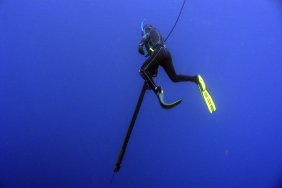 When conditions on the water become less than desirable, to say the least, each angler has their go-to bait to attract strikes and turn things around. As favorite as some of these lures may be, there’s one that is oft-overlooked when it comes to effectiveness in hairy situations: the hair jig. Keep reading to learn how you can use hair jigs to bring fish to the boat when the need arises.
When conditions on the water become less than desirable, to say the least, each angler has their go-to bait to attract strikes and turn things around. As favorite as some of these lures may be, there’s one that is oft-overlooked when it comes to effectiveness in hairy situations: the hair jig. Keep reading to learn how you can use hair jigs to bring fish to the boat when the need arises.
The reason hair jigs work so well is their neutral action, or lack of action altogether. Most lures available today have a distinct action, such as the wobble of a crankbait or the blade of a spinnerbait, but the passive appearance of a hair jig won’t spook fish in conditions where the risk of doing so with too much action is high. This imitates prey like crawfish or leeches, which don’t have much movement in the water.
There are three optimal conditions for hair jigs: cold water (when the waters in your region are considered cold for that region), highly pressured water (during tournaments where many anglers fish a small lake or where fish see pressure year-round, for example), and clear water (visibility of a few feet or more).
When deciding on which hair jigs to keep in the tackle box, color is an important factor. Popular color patterns include black or brown (great crawfish, larvae, and leech imitators), white or grey (mimic baitfish like minnows or shad), and chartreuse (imitate perch or bluegill perfectly). When choosing a size, try to pick a weight that’s heavy enough to keep contact with the bottom. For instance, in shallow water under calm conditions, light jigs—1/16 to 1/8 ounce—work great, while heavier jigs work better in deeper waters on windy days. Due to their lighter weight, I suggest using a seven-foot, medium action rod and fluorocarbon line with jigs. Fluorocarbon is crucial with hair jigs because it sinks and gives a hair jig a more natural presentation, which is critical in tough conditions.
When you’re fishing hair jigs, it’s important to put the bait where the fish are and where they’re feeding on that forage. For instance, during the winter or colder months, fish can be found right along the bottom. In clear, warm waters when the bass are suspended, a white 3/16-ounce jig will be your best friend. Pull it up and down through the school while reeling it in and you’ll hammer them all day.
The passive, natural presentation that hair jigs possess will produce fish time and time again in situations where more active lures won’t. Frustration can set in quickly when conditions become tough on the water. If you find yourself in such a situation, it might be time to tie on a hair jig.








